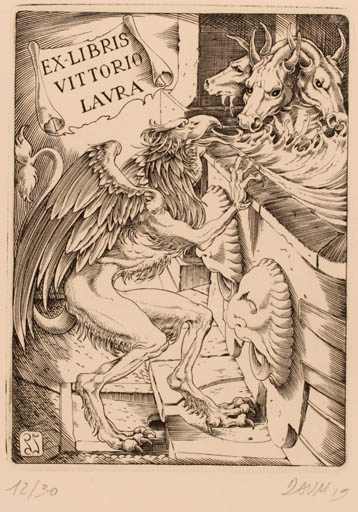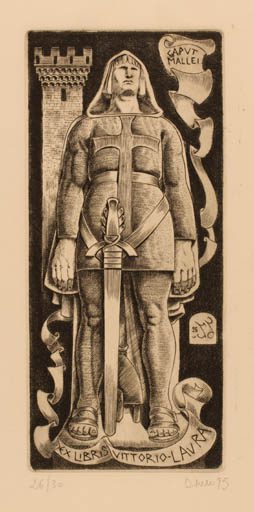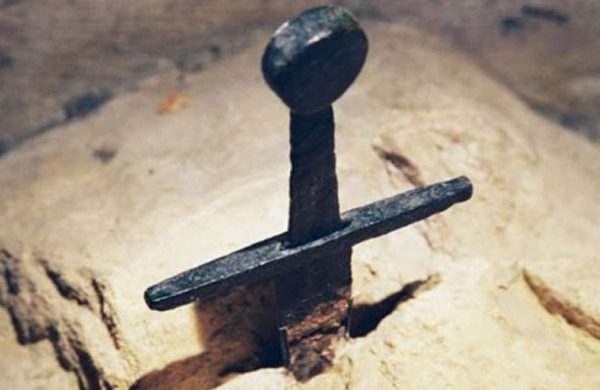Luca Daum & St. Galgano

After my speech in Genoa, there was a long line of people wanting me to sign their copies of The Benedict Option, or just to say hello. One man handed me a large envelope. I didn’t look to see what was in the envelope until I was back at my hotel late that night in Milan, packing for the next morning’s flight.
It was that image above, produced by the man who handed it to me, Luca Daum.
I have searched for everything I could find about him online. Here’s a piece from a Genoa website reporting on a gallery exhibition he had a few years back.
Here are some images of a series of bookplates he created. For example:

And:

In a note he included in the envelope, Luca asked how artists could be involved with the Benedict Option concept. As a general matter, I believe that the creation of beauty is vital to the survival and expansion of the Church, as it always has been. I would like to put the question to you visual and literary artists who are interested in the Ben Op idea. What role do you have to play? How can the rest of us help you?
Here’s one thing you can do: buy Luca Daum’s art. I have his e-mail address, and will happily share it with anybody who writes to me wanting to reach him. I’m going to drop him a note to see if he has a website where he exhibits his work for sale. If we Christians want the world to be more beautiful, then we must support artists.
By the way, I had no idea who Saint Galgano was until I looked at Luca’s etching for me, and then searched for the saint on the Internet. Turns out he’s Galgano Guidotti, a 12th-century Tuscan saint:
Galgano is said to have led a ruthless life in his early years, but later abandoned it in favour of a pious hermitage in the place now known as Rotonda di Montesiepi. His mother, Dionigia, is believed to have reported that Galgano had two visions, both involving Archangel Michael: in the first vision the Archangel told Galgano that he was going to be protected by the Archangel himself. In the second vision, Galgano was following the Archangel and they arrived to the hill of Montesiepi where they met the twelve Apostles and the Creator himself. After the visions, it is said that Galgano’s horse refused to obey his orders and led him on top Montesiepi where his vision happened. Convinced that this was a sign, Galgano decided to plant a cross. Since he had no way to make one of wood, he planted his sword in the ground. The sword is said to have immediately become one piece with the ground so that nobody could remove it. A story says that in one of the visions, he was told to renounce material things. He, stating that it would be as hard as splitting a rock, decided to make his point by attempting to plunge his sword into one. The story goes on saying that the “stone yielded like butter”.
The sword in the stone can be seen at the Rotonda at Montesiepi, near the ruins of the Abbey of San Galgano. The handle of a sword protrudes from the ground, and is said to be the sword of San Galgano.
In Luca Daum’s etching, the miracle of the sword in the stone helped St. Galgano overcome the temptation, symbolized by the vanquished serpent, to believe that it was impossible to separate oneself from material desires. Luca’s etching serves as a kind of icon helping us to understand a spiritual truth about the power of God to empower us to overcome our disordered desires. Sometimes, we can only access these truths in art and literature. I wrote an entire book about how God used the poetry of Dante Alighieri to lead me out of my own dark wood. Dante’s art connected me in a life-changing way with God, in a way that more prosaic forms did not do. Please, readers, keep squarely in front of you the fact that Luca Daum and Christians like him, and the work that they do, are part of the Church too! If the behavior of the clergy, even the Pope, angers and discourages you, make sure to set your eyes on the good works that the faithful do in gratitude to God, and to glorify Him.
Look what The Guardian reported in 2001:
The sword of St Galgano, said to have been plunged into a rock by a medieval Tuscan knight, has been authenticated, bolstering Italy’s version of the Excalibur legend.
Galgano Guidotti, a noble from Chiusdano, near Siena, allegedly split the stone with his sword in 1180 after renouncing war to become a hermit. For centuries the sword was assumed to be a fake. but research revealed last week has dated its metal to the twelfth century.
Only the hilt, wooden grip and a few inches of the 3ft blade poke from the hill, which still draws pilgrims and tourists to the ruins of the chapel built around it.
‘Dating metal is a very difficult task, but we can say that the composition of the metal and the style are compatible with the era of the legend,’ said Luigi Garlaschelli, of the University of Pavia. ‘We have succeeded in refuting those who maintain that it is a recent fake.’
I love Italy. Keep Christianity weird! It’s important.


Subscribe for as little as $5/mo to start commenting on Rod’s blog.